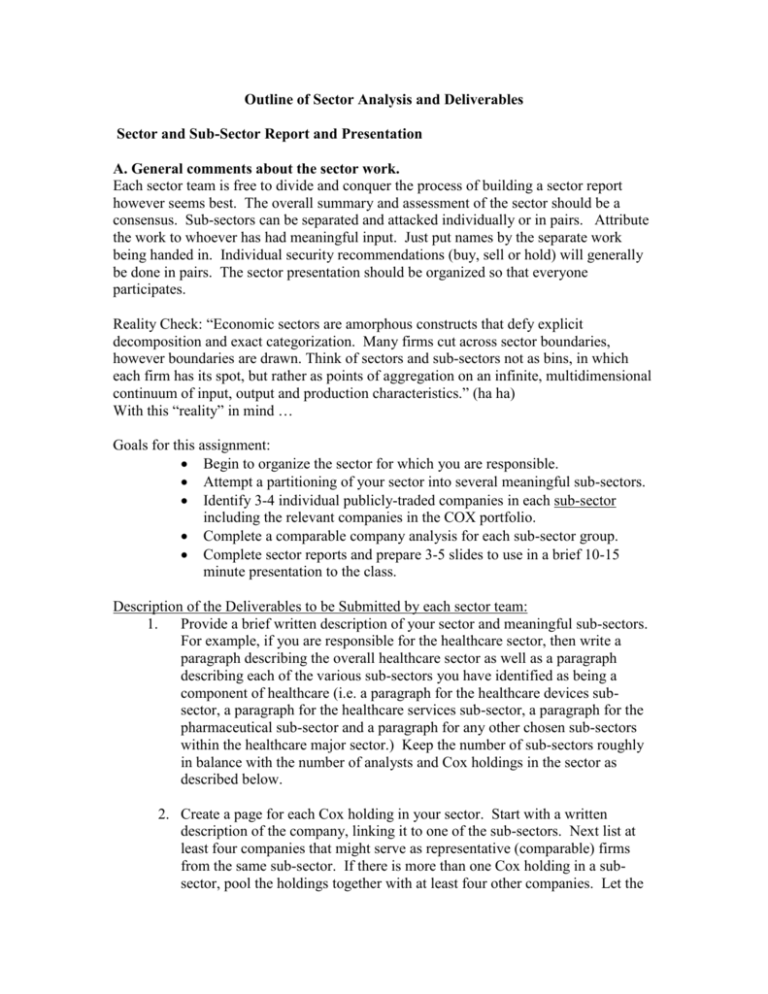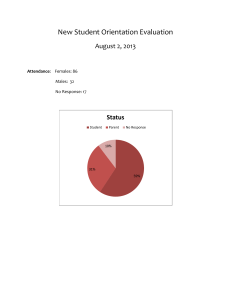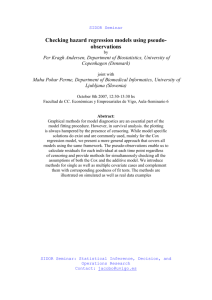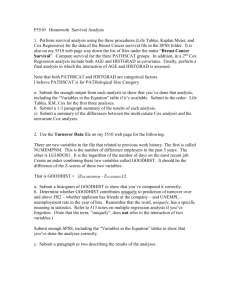2.1 Sector-equity wo..
advertisement

Outline of Sector Analysis and Deliverables Sector and Sub-Sector Report and Presentation A. General comments about the sector work. Each sector team is free to divide and conquer the process of building a sector report however seems best. The overall summary and assessment of the sector should be a consensus. Sub-sectors can be separated and attacked individually or in pairs. Attribute the work to whoever has had meaningful input. Just put names by the separate work being handed in. Individual security recommendations (buy, sell or hold) will generally be done in pairs. The sector presentation should be organized so that everyone participates. Reality Check: “Economic sectors are amorphous constructs that defy explicit decomposition and exact categorization. Many firms cut across sector boundaries, however boundaries are drawn. Think of sectors and sub-sectors not as bins, in which each firm has its spot, but rather as points of aggregation on an infinite, multidimensional continuum of input, output and production characteristics.” (ha ha) With this “reality” in mind … Goals for this assignment: Begin to organize the sector for which you are responsible. Attempt a partitioning of your sector into several meaningful sub-sectors. Identify 3-4 individual publicly-traded companies in each sub-sector including the relevant companies in the COX portfolio. Complete a comparable company analysis for each sub-sector group. Complete sector reports and prepare 3-5 slides to use in a brief 10-15 minute presentation to the class. Description of the Deliverables to be Submitted by each sector team: 1. Provide a brief written description of your sector and meaningful sub-sectors. For example, if you are responsible for the healthcare sector, then write a paragraph describing the overall healthcare sector as well as a paragraph describing each of the various sub-sectors you have identified as being a component of healthcare (i.e. a paragraph for the healthcare devices subsector, a paragraph for the healthcare services sub-sector, a paragraph for the pharmaceutical sub-sector and a paragraph for any other chosen sub-sectors within the healthcare major sector.) Keep the number of sub-sectors roughly in balance with the number of analysts and Cox holdings in the sector as described below. 2. Create a page for each Cox holding in your sector. Start with a written description of the company, linking it to one of the sub-sectors. Next list at least four companies that might serve as representative (comparable) firms from the same sub-sector. If there is more than one Cox holding in a subsector, pool the holdings together with at least four other companies. Let the Cox holdings help define your sub-sectors. Wells Fargo has a natural subsector of regional banking although it has geographic areas of concentration so that it isn’t perfectly comparable to, say, Synovis. Stericycle is more challenging. Is it a healthcare stock or an industrial waste company? Last year’s class split it across industries. Call each Cox holding as you see it and consult across sectors if necessary. Be careful that a stock doesn’t completely fall through the cracks somehow. 3. Describe in broad terms some of the areas within the sector that are not currently covered by a Cox holding. 4. Complete the profile analysis for each of your Cox holdings as well as the associated comparable firms. This creates a “comp sheet” for the Cox holding. As needed, add footnotes with comments you have about a data point such as your source of information and whether there are qualifiers to the information. 5. Compare and contrast from a qualitative perspective the general business model for each of the sub-sectors. For example, you might state that the hardware sub-sector of technology is characterized by high volume yet relatively low gross margins as compared to the software sub-sector within technology is characterized by lower volume yet relatively higher gross margins. At this time you are not concerned with the nuances of the business models for individual companies just the general business models for each of the sub-sectors. 6. Maintain a bibliography of sources and web sites. 7. Submit a full sector report organized using something like the suggested outline below. B. Documentation Outline for Sector Overview ‘ i. Report a. Executive Summary (Address Pos. & Neg. Attributes For Each Sub-Sector also address valuation in broad terms) b. Sector and Sub–sector Market Definitions c. Market Outlook – Qualitative and Quantitative d. General Sector Business Model Summary e. Comparable Company Analysis for each sub-sector where there is a Cox holding. ii. Sector Slides 3-5 slides summarizing the sector report – use graphs and tables where necessary PLEASE SAVE ALL SUBMITTED WORK AS IT WILL BE USED LATER IN THE SEMESTER IN YOUR SECTOR AND ANALYST REPORTS. II. Sell and Hold Reports and Presentations A. Background work: Goals for this phase: To brainstorm about both the positive and negative attributes for each Cox holding vis à vis it’s own sub-sector and the sector in general. To identify holdings with the greatest prospect for a sell recommendation and sub-sectors with the greatest prospect for future buy recommendations. Note, the work for the Buy idea will be completed in the Spring semester but it is wise to be thinking about possible future Buy ideas throughout the course of the fall semester. Think critically about the business models, market outlook, and valuation for your Sell and Hold recommendations. Consider how you might conduct third-party due diligence to help facilitate your Sell and/or Hold decisions. Summarize all of your Qualitative and Quantitative work thus far for your Sell and Hold Recommendations and develop the key Investment Thesis points. At this point, you should be able to: 1. Compare and contrast each of the sub-sectors based on the work you have completed thus far. Address both fundamentals (i.e. growth characteristics, qualitative value drivers, business model issues) as well as valuation and risk. Also address the qualitative issues such as the major positive and / or negative trends that you see in that sub-sector. If there is a current portfolio holding in that sub-sector, address your current thoughts for that holding and the direction you are headed speaking to both fundamental and valuation issues. 2. Summarize your thinking so you can describe each name in these terms: Sub-Sector Cox Holding Sell, Hold , Add Overarching Rationale (sub-sector and individual stock) Summary of Fundamentals Summary of Valuation 3. Attempt some primary research. Good analysts identify customer, supplier and competitor contacts for each sub-sector they follow. See if you can engage in some dialogue with a “contact” within the sub-sector of a potential sell recommendation. Contacts are helpful in corroborating external assessments of a market. 4. Identify Investment Thesis Points for the Sell/hold recommendation– Drivers that could decelerate the future growth of the market beyond consensus: e.g. Price Competition or Negative Sector/Market trends Drivers that could decelerate revenue growth beyond consensus Drivers that will possibly increase costs beyond consensus Drivers that decrease the value of assets beyond consensus Drivers that will possibly increase the value of liabilities beyond consensus Weak Points from the Profile Analysis and comp. sheet. Factors that might cause multiple compression in the future. B. Prepare final Sell and/or Hold Report: Goals: Complete Sell and/or Hold reports, patterned after your favorite reports seen in class or elsewhere – refer to the Analyst Report Scorecard for additional guidance along with the best practice handout. Prepare 4-6 slides for Sell recommendations and 2-3 slides for Hold recommendations to use as visual aids for your class presentations. III. Buy Recommendation Repeat steps used for Sell/Hold Recommendations. However, it is suggested that for the Buy Recommendations that you supplement your due diligence efforts with additional contacts and/or resources to further substantiate your decision. Additionally, the report outline for the Buy Recommendation is more detailed as shown below. B. Buy Recommendation Documentation Outline i. Company Buy Recommendation Report a. Cover and Summary Statistics Page b. Table of Contents c. Company Description d. Investment Highlights and Risks e. Market Overview f. Competition – see notes below 1. Competitive Factors 2. Ranking based on competitive factors checklist g. Products and Services h. Business Model Overview i. Customers j. Due Diligence Summary k. Valuation 1. Summary and Methodology 2. Detailed Comparable Company Analysis 3. P/E to Growth Rate 4. Earnings Forecast 5. Ratio Analysis 6. Discounted Cash Flow Analysis 7. Dividend Discount Model (if warranted) 8. Trailing P/E Analysis (if warranted) The competitive factors matrix is used to highlight a particular company’s strengths and weaknesses relative to its peer groups. The competitive factors are more qualitative rather than quantitative in nature. Competitive factors are factors that a potential customer might look at when evaluating a vendor’s products and services. In completing the matrix, we suggest reading the “Competition” section of the 10-K filings of each of the companies in question. Below is an oversimplified example of a competitive factors matrix for Best Buy. Value Proposition Price Selection Service Product Quality Best Buy * * * Circuit City * * * Wal-Mart * *









